A Broadband Vortex Beam Generator Based on Single-Layer Hybrid Phase-Turning Metasurface
Abstract
:1. Introduction
2. Metasurface Design
3. Experimental Result
4. Conclusions
Author Contributions
Funding
Data Availability Statement
Conflicts of Interest
References
- Yao, A.M.; Padgett, M.J. Orbital angular momentum: Origins, behavior and applications. Adv. Opt. Photonics 2011, 3, 161–204. [Google Scholar] [CrossRef] [Green Version]
- Mohammadi, S.M.; Daldorff, L.K.S.; Bergman, J.E.S.; Karlsson, R.L.; Thide, B.; Forozesh, K.; Carozzi, T.D.; Isham, B. Orbital Angular Momentum in Radio—A System Study. IEEE Trans. Antennas Propag. 2010, 58, 565–572. [Google Scholar] [CrossRef]
- Wang, J.; Yang, J.-Y.; Fazal, I.M.; Ahmed, N.; Yan, Y.; Huang, H.; Ren, Y.; Yue, Y.; Dolinar, S.; Tur, M.; et al. Terabit free-space data transmission employing orbital angular momentum multiplexing. Nat. Photonics 2012, 6, 488–496. [Google Scholar] [CrossRef]
- Tamburini, F.; Mari, E.; Sponselli, A.; Thidé, B.; Bianchini, A.; Romanato, F. Encoding many channels on the same frequency through radio vorticity: First experimental test. New J. Phys. 2012, 14, 033001. [Google Scholar] [CrossRef] [Green Version]
- Yan, Y.; Xie, G.; Lavery, M.P.; Huang, H.; Ahmed, N.; Bao, C.; Ren, Y.; Cao, Y.; Li, L.; Zhao, Z.; et al. High-capacity millimetre-wave communications with orbital angular momentum multiplexing. Nat. Commun. 2014, 5, 4876. [Google Scholar] [CrossRef] [PubMed] [Green Version]
- Zhang, Y.-M.; Li, J.-L. An Orbital Angular Momentum-Based Array for In-Band Full-Duplex Communications. IEEE Antennas Wirel. Propag. Lett. 2019, 18, 417–421. [Google Scholar] [CrossRef]
- Gong, Y.; Wang, R.; Deng, Y.; Zhang, B.; Wang, N.; Li, N.; Wang, P. Generation and Transmission of OAM-Carrying Vortex Beams Using Circular Antenna Array. IEEE Trans. Antennas Propag. 2017, 65, 2940–2949. [Google Scholar] [CrossRef]
- Muelas-Hurtado, R.D.; Ealo, J.L.; Pazos-Ospina, J.F.; Volke-Sepúlveda, K. Generation of multiple vortex beam by means of active diffraction gratings. Appl. Phys. Lett. 2018, 112, 084101. [Google Scholar] [CrossRef] [Green Version]
- Tamburini, F.; Mari, E.; Thidé, B.; Barbieri, C.; Romanato, F. Experimental verification of photon angular momentum and vorticity with radio techniques. Appl. Phys. Lett. 2011, 99, 204102. [Google Scholar] [CrossRef]
- Byun, W.-J.; Lee, Y.-S.; Kim, B.S.; Kim, K.S.; Kang, M.S.; Cho, Y.H. Simple generation of orbital angular momentum modes with azimuthally deformed Cassegrain subreflector. Electron. Lett. 2015, 51, 1480–1482. [Google Scholar] [CrossRef]
- Chen, W.T.; Yang, K.Y.; Wang, C.M.; Huang, Y.W.; Sun, G.; Chiang, I.D.; Liao, C.Y.; Hsu, W.L.; Lin, H.T.; Sun, S.; et al. High-efficiency broadband meta-hologram with polarization-controlled dual images. Nano Lett. 2014, 14, 225–230. [Google Scholar] [CrossRef] [PubMed]
- Qiao, L.; Wang, Y.; Shen, Z.; Zhao, Z.; Chen, Z. Compressive sensing for direct millimeter-wave holographic imaging. Appl. Opt. 2015, 54, 3280–3289. [Google Scholar] [CrossRef] [PubMed]
- Veksler, D.; Maguid, E.; Shitrit, N.; Ozeri, D.; Kleiner, V.; Hasman, E. Multiple Wavefront Shaping by Metasurface Based on Mixed Random Antenna Groups. ACS Photonics 2015, 2, 661–667. [Google Scholar] [CrossRef]
- Wan, X.; Xiang Jiang, W.; Feng Ma, H.; Jun Cui, T. A broadband transformation-optics metasurface lens. Appl. Phys. Lett. 2014, 104, 151601. [Google Scholar] [CrossRef]
- Yu, N.; Capasso, F. Flat optics with designer metasurfaces. Nat. Mater. 2014, 13, 139–150. [Google Scholar] [CrossRef]
- Shen, X.; Cui, T.J.; Zhao, J.; Ma, H.F.; Jiang, W.X.; Li, H. Polarization-independent wide-angle triple-band metamaterial absorber. Opt. Express 2011, 19, 9401–9407. [Google Scholar] [CrossRef]
- Zhao, J.; Cheng, Q.; Chen, J.; Qi, M.Q.; Jiang, W.X.; Cui, T.J. A tunable metamaterial absorber using varactor diodes. New J. Phys. 2013, 15, 043049. [Google Scholar] [CrossRef]
- Yang, J.; Zhang, C.; Ma, H.F.; Zhao, J.; Dai, J.Y.; Yuan, W.; Yang, L.X.; Cheng, Q.; Cui, T.J. Generation of radio vortex beams with designable polarization using anisotropic frequency selective surface. Appl. Phys. Lett. 2018, 112, 203501. [Google Scholar] [CrossRef]
- Chen, M.L.N.; Jiang, L.J.; Sha, W.E.I. Quasi-Continuous Metasurfaces for Orbital Angular Momentum Generation. IEEE Antennas Wirel. Propag. Lett. 2019, 18, 477–481. [Google Scholar] [CrossRef] [Green Version]
- Chen, M.L.N.; Jiang, L.J.; Sha, W.E.I. Ultrathin Complementary Metasurface for Orbital Angular Momentum Generation at Microwave Frequencies. IEEE Trans. Antennas Propag. 2017, 65, 396–400. [Google Scholar] [CrossRef] [Green Version]
- Jiang, S.; Chen, C.; Ding, J.; Zhang, H.; Chen, W. Alleviating Orbital-Angular-Momentum-Mode Dispersion Using a Reflective Metasurface. Phys. Rev. Appl. 2020, 13, 054037. [Google Scholar] [CrossRef]
- Huang, J.; Cao, Z.; Zhao, X.; Zhang, X.; Liu, Y.; Xiang, Y.; Gerini, G.; Koonen, A.M.J. Optical Generation/Detection of Broadband Microwave Orbital Angular Momentum Modes. J. Light Technol. 2020, 38, 1202–1209. [Google Scholar] [CrossRef]
- Liu, K.; Cheng, Y.; Yang, Z.; Wang, H.; Qin, Y.; Li, X. Orbital-Angular-Momentum-Based Electromagnetic Vortex Imaging. IEEE Antennas Wirel. Propag. Lett. 2015, 14, 711–714. [Google Scholar] [CrossRef]
- Cvijetic, N.; Milione, G.; Ip, E.; Wang, T. Detecting Lateral Motion using Light’s Orbital Angular Momentum. Sci. Rep. 2015, 5, 15422. [Google Scholar] [CrossRef] [Green Version]
- Guo, K.; Zheng, Q.; Yin, Z.; Guo, Z. Generation of Mode-Reconfigurable and Frequency-Adjustable OAM Beams Using Dynamic Reflective Metasurface. IEEE Access 2020, 8, 75523–75529. [Google Scholar] [CrossRef]
- Li, B.; Jing, P.F.; Sun, L.Q.; Leung, K.W.; Lv, X. 3D Printed OAM Reflectarray Using Half-Wavelength Rectangular Dielectric Element. IEEE Access 2020, 8, 142892–142899. [Google Scholar] [CrossRef]
- Wu, J.; Zhang, Z.; Ren, X.; Huang, Z.; Wu, X. A Broadband Electronically Mode-Reconfigurable Orbital Angular Momentum Metasurface Antenna. IEEE Antennas Wirel. Propag. Lett. 2019, 18, 1482–1486. [Google Scholar] [CrossRef]
- Bi, F.; Ba, Z.; Wang, X. Metasurface-based broadband orbital angular momentum generator in millimeter wave region. Opt. Express 2018, 26, 25693–25705. [Google Scholar] [CrossRef]
- Yu, Z.-Y.; Zhang, Y.-H.; Gao, H.-T. A High-Efficiency and Broadband Folded Reflectarray Based on an Anisotropic Metasurface for Generating Orbital Angular Momentum Vortex Beams. IEEE Access 2021, 9, 87360–87369. [Google Scholar] [CrossRef]
- Liu, B.; Li, Y.; Rashid, A.K.; Jiang, X.; Wong, S.-W.; Zhang, X.; Tam, K.W.; Zhang, Q. High-Gain Broadband Millimeter-Wave Multidimensional Metasurface for Generating Two Independent Vortex Waves. IEEE Trans. Antennas Propag. 2022, 70, 8195–8203. [Google Scholar] [CrossRef]
- Huang, C.; Pan, W.; Ma, X.; Luo, X. Multi-spectral Metasurface for Different Functional Control of Reflection Waves. Sci. Rep. 2016, 6, 23291. [Google Scholar] [CrossRef] [PubMed] [Green Version]
- Liu, Y.; Ke, Y.; Zhou, J.; Liu, Y.; Luo, H.; Wen, S.; Fan, D. Generation of perfect vortex and vector beams based on Pancharatnam-Berry phase elements. Sci. Rep. 2017, 7, 44096. [Google Scholar] [CrossRef] [PubMed] [Green Version]
- Xu, H.-X.; Liu, H.; Ling, X.; Sun, Y.; Yuan, F. Broadband Vortex Beam Generation Using Multimode Pancharatnam–Berry Metasurface. IEEE Trans. Antennas Propag. 2017, 65, 7378–7382. [Google Scholar] [CrossRef]
- Zhang, X.; Yang, F.; Xu, S.; Aziz, A.; Li, M. Hybrid Polarization-Phase Tuning Methodology for Reflectarray Antennas. IEEE Trans. Antennas Propag. 2021, 69, 5534–5545. [Google Scholar] [CrossRef]
- Zhao, J.; Fu, C.; Li, H.; Li, F.; Hu, X. A Single-Layer Broadband Ka-Band Reflectarray Using Novel Windmill Elements. IEEE Trans. Antennas Propag. 2022, 70, 11167–11171. [Google Scholar] [CrossRef]
- Zheng, S.; Hao, H.; Tang, Y.; Ran, X. High-purity orbital angular momentum vortex beam generator using an amplitude-and-phase metasurface. Opt. Lett. 2021, 46, 5790–5793. [Google Scholar] [CrossRef] [PubMed]
- Valizade Shahmirzadi, A.; Kishk, A.A. OAM Carrying Vortex Beam Mode Interconversion Using Modular Cascaded Transmitarrays. IEEE Trans. Microw. Theory Tech. 2022, 70, 3591–3605. [Google Scholar] [CrossRef]
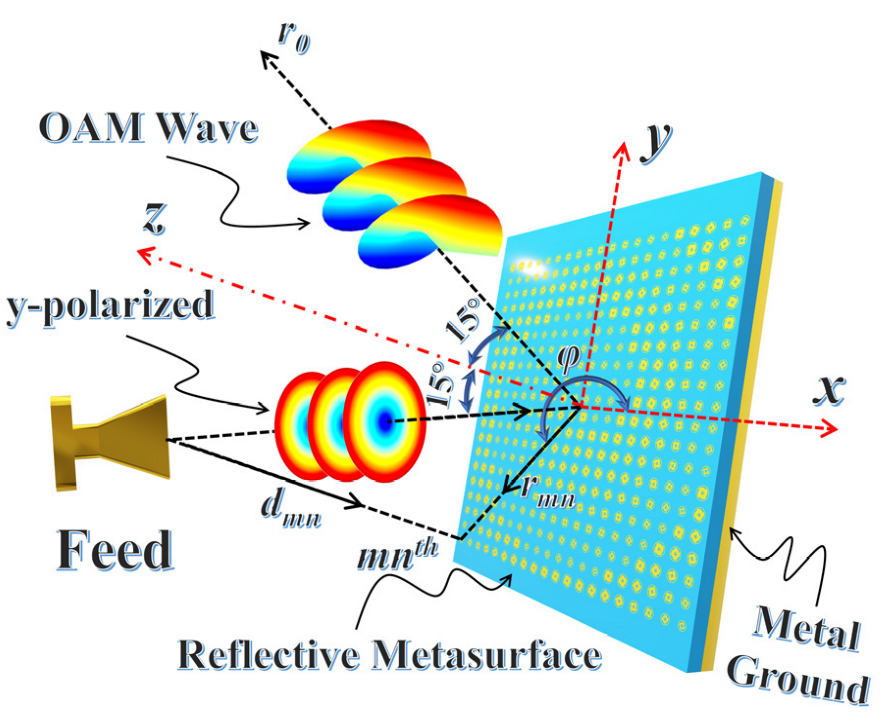
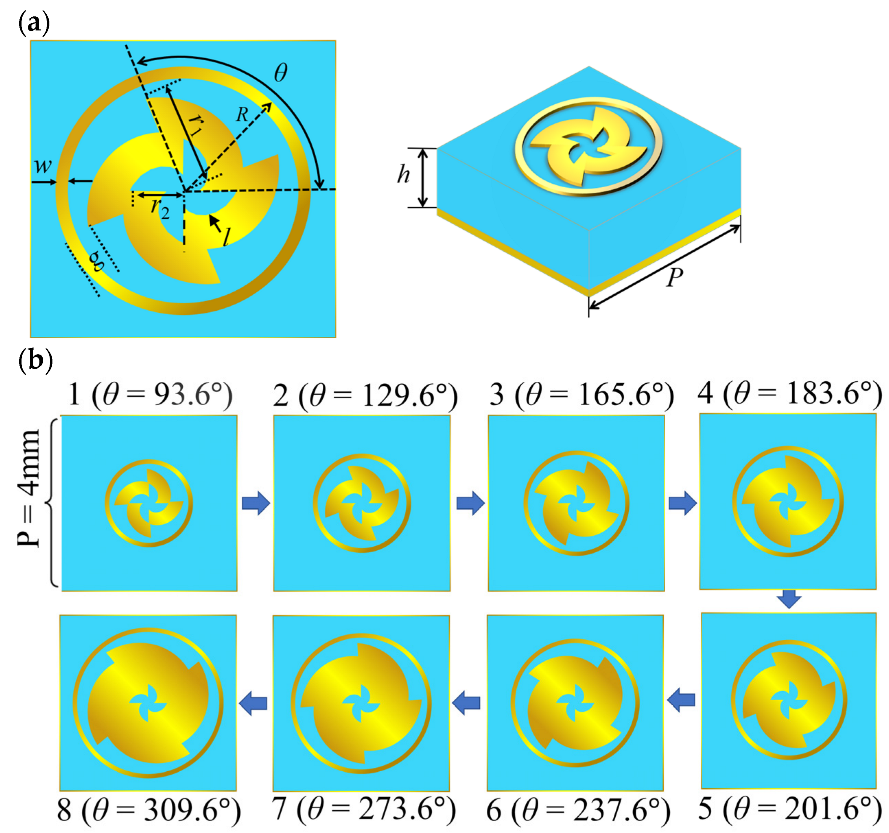
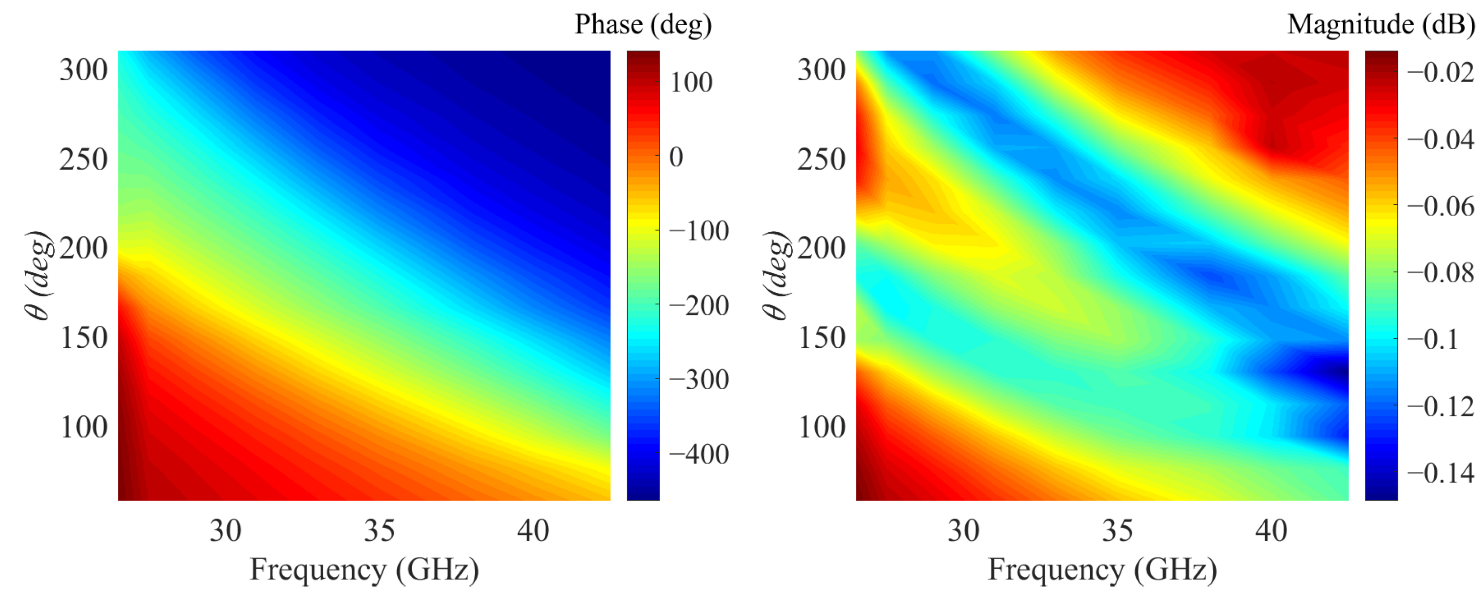

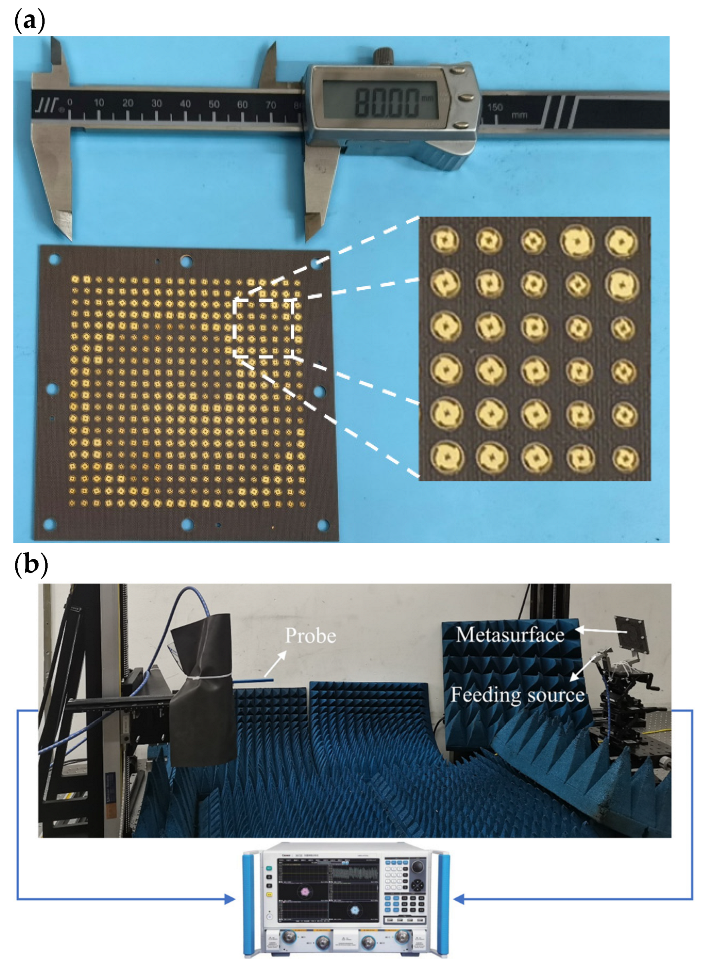


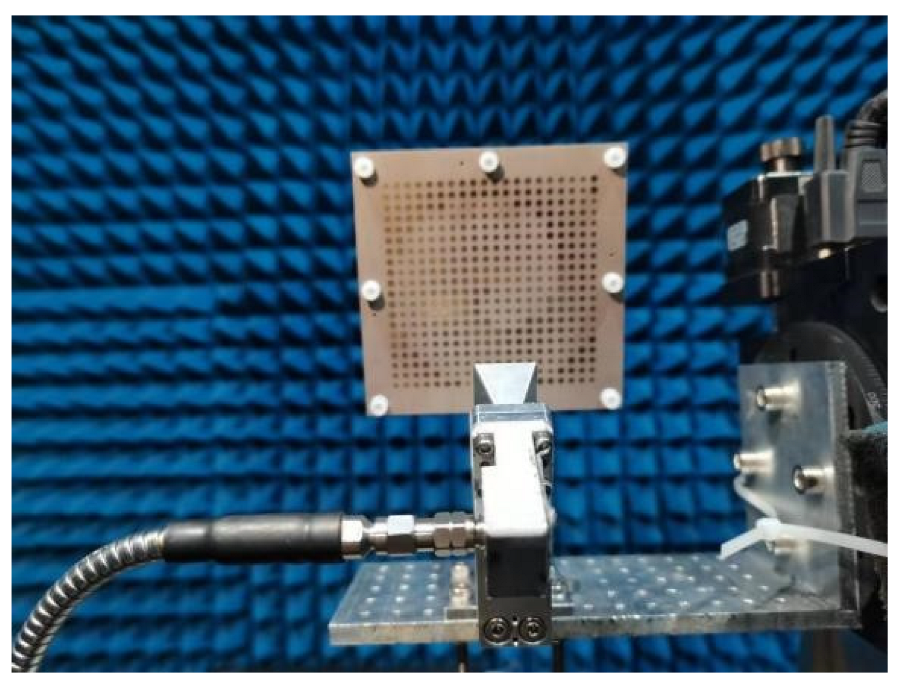
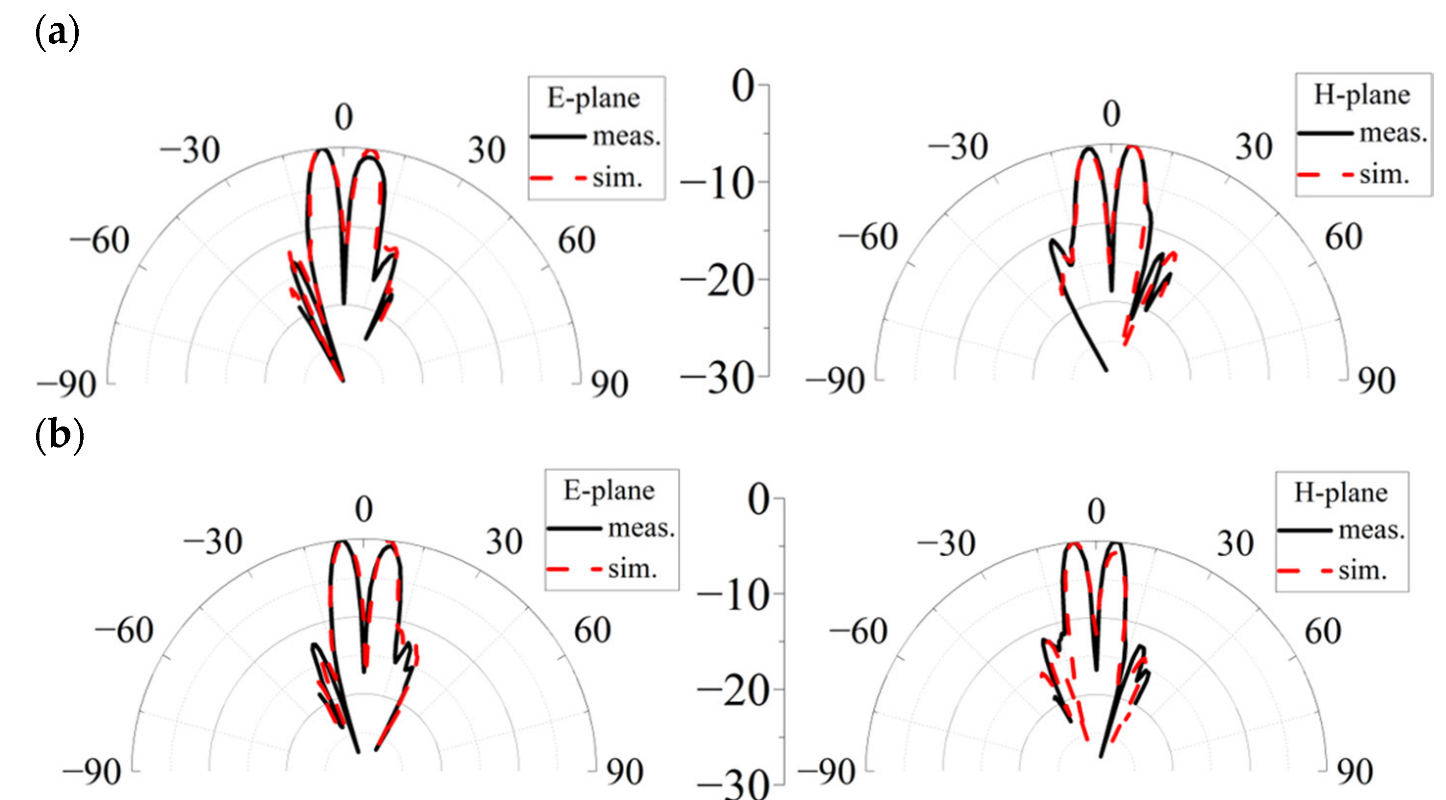

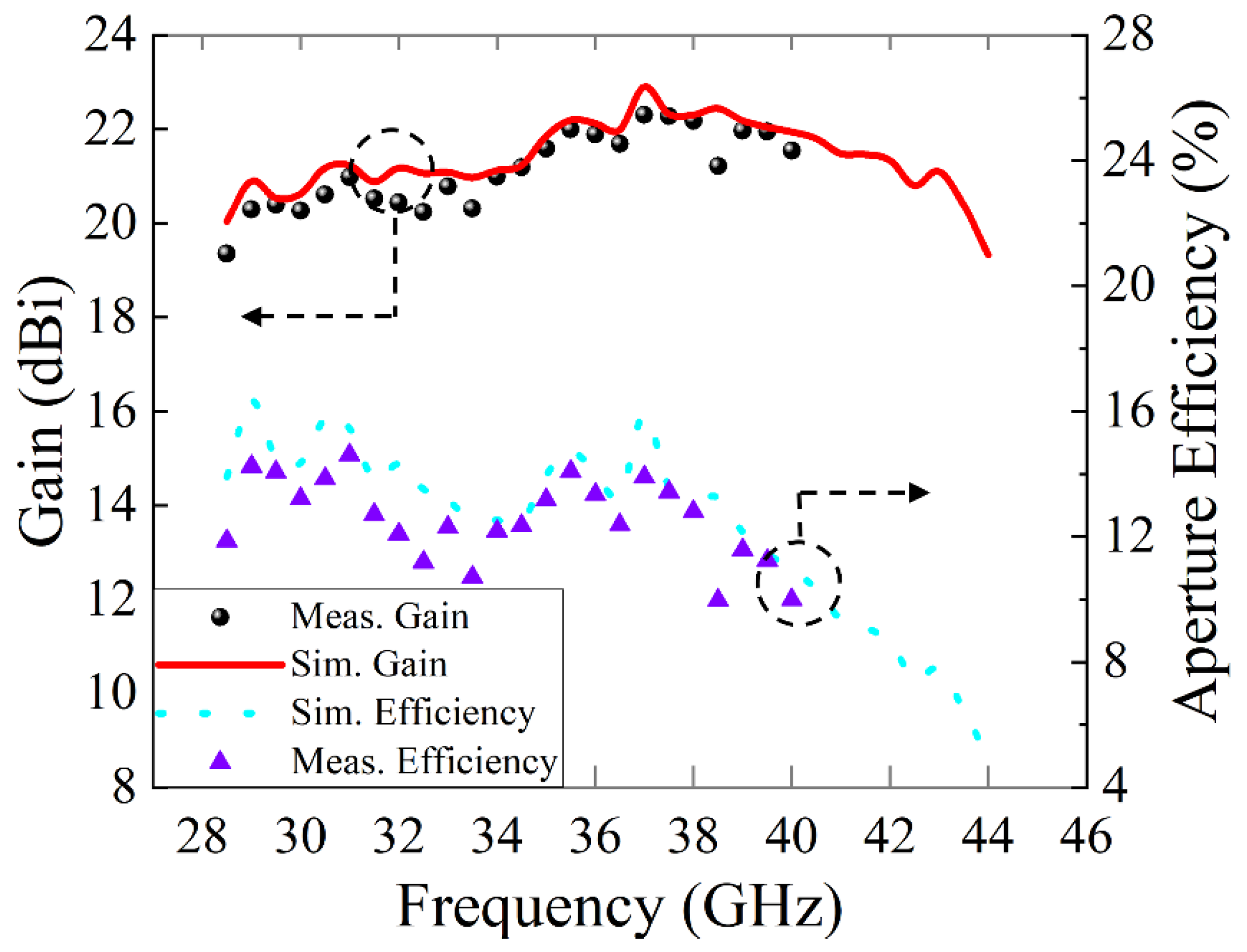
| Frequency (GHz) | 26.5 | 30 | 32 | 35 | 37 | 40 |
|---|---|---|---|---|---|---|
| Measured Max. purity | 72% | 72% | 73% | 80% | 76% | 71% |
| Measured Max. Crosstalk (dB) | −14.28 | −20.24 | −18.76 | −26.34 | −18.02 | −15.61 |
| Ref. | Frequency (GHz) | Thickness | Aperture Size | No. of Substrates | Mode Purity Bandwidth | Peak AE. | Max. Crosstalk (dB) | 3 dB Gain Bandwidth (%) |
|---|---|---|---|---|---|---|---|---|
| [25] | 5.5 | 0.027λ0 | 2.57λ0 | 1 | 11% (>60%) | 11.9% | — | — |
| [26] | 30 | 0.6λ0 | 10λ0 | 1 | 21.7% (>60%) | 8% | — | — |
| [27] | 5.7 | 0.069λ0 | 2.38λ0 | 4 | 21.5% (>63.6%) | 18.46% | — | — |
| [28] | 67 | 0.14λ0 | 49λ0 | 1 | 17.1% (>75.5%) | — | <−10 | — |
| [29] | 12 | 0.1λ0 | 9.6λ0 | 2 | 22.5% (>75%) | 20.2% | — | 25% |
| This work | 35 | 0.13λ0 | 9.3λ0 | 1 | 38.57% (>70%) | 13.88% | <−14 | 42.86% |
Disclaimer/Publisher’s Note: The statements, opinions and data contained in all publications are solely those of the individual author(s) and contributor(s) and not of MDPI and/or the editor(s). MDPI and/or the editor(s) disclaim responsibility for any injury to people or property resulting from any ideas, methods, instructions or products referred to in the content. |
© 2023 by the authors. Licensee MDPI, Basel, Switzerland. This article is an open access article distributed under the terms and conditions of the Creative Commons Attribution (CC BY) license (https://creativecommons.org/licenses/by/4.0/).
Share and Cite
Fu, C.; Zhao, J.; Li, F.; Li, H. A Broadband Vortex Beam Generator Based on Single-Layer Hybrid Phase-Turning Metasurface. Micromachines 2023, 14, 465. https://doi.org/10.3390/mi14020465
Fu C, Zhao J, Li F, Li H. A Broadband Vortex Beam Generator Based on Single-Layer Hybrid Phase-Turning Metasurface. Micromachines. 2023; 14(2):465. https://doi.org/10.3390/mi14020465
Chicago/Turabian StyleFu, Cheng, Jianing Zhao, Fang Li, and Hao Li. 2023. "A Broadband Vortex Beam Generator Based on Single-Layer Hybrid Phase-Turning Metasurface" Micromachines 14, no. 2: 465. https://doi.org/10.3390/mi14020465
APA StyleFu, C., Zhao, J., Li, F., & Li, H. (2023). A Broadband Vortex Beam Generator Based on Single-Layer Hybrid Phase-Turning Metasurface. Micromachines, 14(2), 465. https://doi.org/10.3390/mi14020465







